|
F6647 |
3105 |
8 - MK |
|
SHEL-f |
|
106 - Natural History Museum UK (?) |
IV |
|
|
-- |
|
152 - W. Auffenberg |
|
|
Unknown |
|
Reptilia |
Testudines |
|
|
|
|
|
|
|
|
|
The author mentions there are over 3,000 fossilized turtle fragments from Olduvai Gorge, 98% of which are from the species Pelusios sinuatus. However, it is unclear which specimens belong to which species based on the description given. When it was unclear, the specimen is only referred to as belonging to the Order Testudines. |
No |
|
OVPP-Testudines 12 |
6846 |
|
|
CARA, PLAS |
|
106 - Natural History Museum UK (?) |
|
|
|
-- |
|
152 - W. Auffenberg |
|
|
Unknown |
|
Reptilia |
Testudines |
|
|
|
|
|
|
|
|
|
The author mentions there are over 3,000 fossilized turtle fragments from Olduvai Gorge, 98% of which are from the species Pelusios sinuatus. However, it is unclear which specimens belong to which species based on the description given. When it was unclear, the specimen is only referred to as belonging to the Order Testudines. |
No |
|
NN42 |
6847 |
|
|
CARA-f |
|
106 - Natural History Museum UK (?) |
|
|
|
-- |
The authors say this specimen comes from "NN" though this is not a known locality. Perhaps it comes from FLK NN. |
152 - W. Auffenberg |
|
|
Unknown |
|
Reptilia |
Testudines |
|
|
|
|
|
|
|
|
|
The author mentions there are over 3,000 fossilized turtle fragments from Olduvai Gorge, 98% of which are from the species Pelusios sinuatus. However, it is unclear which specimens belong to which species based on the description given. When it was unclear, the specimen is only referred to as belonging to the Order Testudines. |
No |
|
F6250 |
6852 |
69 - GRK S |
|
CARA, PLAS-f |
|
106 - Natural History Museum UK (?) |
|
|
|
-- |
|
152 - W. Auffenberg |
|
|
Unknown |
|
Reptilia |
Testudines |
|
|
|
|
|
|
|
|
|
The author mentions there are over 3,000 fossilized turtle fragments from Olduvai Gorge, 98% of which are from the species Pelusios sinuatus. However, it is unclear which specimens belong to which species based on the description given. When it was unclear, the specimen is only referred to as belonging to the Order Testudines. |
No |
|
OVPP-Testudines 15 |
6853 |
18 - VEK |
|
SHEL-f |
|
106 - Natural History Museum UK (?) |
|
|
|
-- |
|
152 - W. Auffenberg |
|
|
Unknown |
|
Reptilia |
Testudines |
|
|
|
|
|
|
|
|
|
The author mentions there are over 3,000 fossilized turtle fragments from Olduvai Gorge, 98% of which are from the species Pelusios sinuatus. However, it is unclear which specimens belong to which species based on the description given. When it was unclear, the specimen is only referred to as belonging to the Order Testudines. |
No |
|
F42 |
3049 |
6 - FLK NN |
|
PLR |
|
106 - Natural History Museum UK (?) |
I |
|
|
Auffenberg, W. 1981. The fossil turtles of Olduvai Gorge, Tanzania, Africa. Copeia 1981:509-522. |
|
152 - W. Auffenberg |
|
|
Unknown |
|
Reptilia |
Testudines |
|
|
|
|
|
|
|
|
|
The author mentions there are over 3,000 fossilized turtle fragments from Olduvai Gorge, 98% of which are from the species Pelusios sinuatus. However, it is unclear which specimens belong to which species based on the description given. When it was unclear, the specimen is only referred to as belonging to the Order Testudines. |
No |
|
OVPP-Testudines 12 |
3079 |
|
|
CARA, PLAS |
|
106 - Natural History Museum UK (?) |
|
|
|
-- |
|
152 - W. Auffenberg |
|
|
Unknown |
|
Reptilia |
Testudines |
|
|
|
|
|
|
|
|
|
The author mentions there are over 3,000 fossilized turtle fragments from Olduvai Gorge, 98% of which are from the species Pelusios sinuatus. However, it is unclear which specimens belong to which species based on the description given. When it was unclear, the specimen is only referred to as belonging to the Order Testudines. |
No |
|
NN42 |
3080 |
|
|
CARA-f |
|
106 - Natural History Museum UK (?) |
|
|
|
-- |
The authors say this specimen comes from "NN" though this is not a known locality. Perhaps it comes from FLK NN. |
152 - W. Auffenberg |
|
|
Unknown |
|
Reptilia |
Testudines |
|
|
|
|
|
|
|
|
|
The author mentions there are over 3,000 fossilized turtle fragments from Olduvai Gorge, 98% of which are from the species Pelusios sinuatus. However, it is unclear which specimens belong to which species based on the description given. When it was unclear, the specimen is only referred to as belonging to the Order Testudines. |
No |
|
F84 |
3083 |
11 - HWK |
|
PERI |
|
106 - Natural History Museum UK (?) |
II |
|
|
-- |
|
152 - W. Auffenberg |
|
|
Unknown |
|
Reptilia |
Testudines |
|
|
|
|
|
|
|
|
|
The author mentions there are over 3,000 fossilized turtle fragments from Olduvai Gorge, 98% of which are from the species Pelusios sinuatus. However, it is unclear which specimens belong to which species based on the description given. When it was unclear, the specimen is only referred to as belonging to the Order Testudines. |
No |
|
F6250 |
3085 |
69 - GRK S |
|
CARA, PLAS-f |
|
106 - Natural History Museum UK (?) |
|
|
|
-- |
|
152 - W. Auffenberg |
|
|
Unknown |
|
Reptilia |
Testudines |
|
|
|
|
|
|
|
|
|
The author mentions there are over 3,000 fossilized turtle fragments from Olduvai Gorge, 98% of which are from the species Pelusios sinuatus. However, it is unclear which specimens belong to which species based on the description given. When it was unclear, the specimen is only referred to as belonging to the Order Testudines. |
No |
|
OVPP-Testudines 15 |
3086 |
18 - VEK |
|
SHEL-f |
|
106 - Natural History Museum UK (?) |
|
|
|
-- |
|
152 - W. Auffenberg |
|
|
Unknown |
|
Reptilia |
Testudines |
|
|
|
|
|
|
|
|
|
The author mentions there are over 3,000 fossilized turtle fragments from Olduvai Gorge, 98% of which are from the species Pelusios sinuatus. However, it is unclear which specimens belong to which species based on the description given. When it was unclear, the specimen is only referred to as belonging to the Order Testudines. |
No |
|
OVPP-Testudines 16 |
3087 |
70 - EHK |
|
SHEL-f |
|
106 - Natural History Museum UK (?) |
I |
|
|
-- |
|
152 - W. Auffenberg |
|
|
Unknown |
|
Reptilia |
Testudines |
|
|
|
|
|
|
|
|
|
The author mentions there are over 3,000 fossilized turtle fragments from Olduvai Gorge, 98% of which are from the species Pelusios sinuatus. However, it is unclear which specimens belong to which species based on the description given. When it was unclear, the specimen is only referred to as belonging to the Order Testudines. |
No |
|
OVPP-Testudines 17 |
3088 |
9 - THC |
|
SHEL-f |
|
106 - Natural History Museum UK (?) |
I |
|
|
-- |
|
152 - W. Auffenberg |
|
|
Unknown |
|
Reptilia |
Testudines |
|
|
|
|
|
|
|
|
|
The author mentions there are over 3,000 fossilized turtle fragments from Olduvai Gorge, 98% of which are from the species Pelusios sinuatus. However, it is unclear which specimens belong to which species based on the description given. When it was unclear, the specimen is only referred to as belonging to the Order Testudines. |
No |
|
OVPP-Testudines 18 |
3095 |
22 - SC |
|
SHEL-f |
|
106 - Natural History Museum UK (?) |
II |
|
|
-- |
|
152 - W. Auffenberg |
|
|
Unknown |
|
Reptilia |
Testudines |
|
|
|
|
|
|
|
|
|
The author mentions there are over 3,000 fossilized turtle fragments from Olduvai Gorge, 98% of which are from the species Pelusios sinuatus. However, it is unclear which specimens belong to which species based on the description given. When it was unclear, the specimen is only referred to as belonging to the Order Testudines. |
No |
|
F556 |
3101 |
8 - MK |
|
SHEL-f |
|
106 - Natural History Museum UK (?) |
IV |
|
|
-- |
|
152 - W. Auffenberg |
|
|
Unknown |
|
Reptilia |
Testudines |
|
|
|
|
|
|
|
|
|
The author mentions there are over 3,000 fossilized turtle fragments from Olduvai Gorge, 98% of which are from the species Pelusios sinuatus. However, it is unclear which specimens belong to which species based on the description given. When it was unclear, the specimen is only referred to as belonging to the Order Testudines. |
No |
|
F565 |
3102 |
8 - MK |
|
SHEL-f |
|
106 - Natural History Museum UK (?) |
IV |
|
|
-- |
|
152 - W. Auffenberg |
|
|
Unknown |
|
Reptilia |
Testudines |
|
|
|
|
|
|
|
|
|
The author mentions there are over 3,000 fossilized turtle fragments from Olduvai Gorge, 98% of which are from the species Pelusios sinuatus. However, it is unclear which specimens belong to which species based on the description given. When it was unclear, the specimen is only referred to as belonging to the Order Testudines. |
No |
|
F57 |
3103 |
8 - MK |
|
SHEL-f |
|
106 - Natural History Museum UK (?) |
IV |
|
|
-- |
|
152 - W. Auffenberg |
|
|
Unknown |
|
Reptilia |
Testudines |
|
|
|
|
|
|
|
|
|
The author mentions there are over 3,000 fossilized turtle fragments from Olduvai Gorge, 98% of which are from the species Pelusios sinuatus. However, it is unclear which specimens belong to which species based on the description given. When it was unclear, the specimen is only referred to as belonging to the Order Testudines. |
No |
|
F645 |
3104 |
8 - MK |
|
SHEL-f |
|
106 - Natural History Museum UK (?) |
IV |
|
|
-- |
|
152 - W. Auffenberg |
|
|
Unknown |
|
Reptilia |
Testudines |
|
|
|
|
|
|
|
|
|
The author mentions there are over 3,000 fossilized turtle fragments from Olduvai Gorge, 98% of which are from the species Pelusios sinuatus. However, it is unclear which specimens belong to which species based on the description given. When it was unclear, the specimen is only referred to as belonging to the Order Testudines. |
No |
|
M. 21470 |
117 |
12 - CK |
|
R-HOR-f |
1935 |
106 - Natural History Museum UK (?) |
|
|
|
Leakey LSB. 1965. Olduvai Gorge 1951-1961, Volume 1: Fauna and Background. New York, NY: Cambridge University Press. |
|
130 - L.S.B. Leakey |
|
264 - Leakey family expedition |
No |
|
Mammalia |
Artiodactyla |
Ruminantia |
|
Bovoidea |
Bovidae |
Bovinae |
Strepsicerotini |
Strepsiceros |
sp. |
|
This specimen was reclassified as Tragelaphus stepsiceros by Gentry and Gentry (1978). |
No |
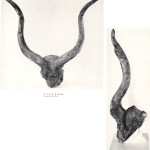 |
M. 21461 |
118 |
13 - RK |
|
CRA, R/L-HOR, R-I, R-P, R-M |
1931 |
106 - Natural History Museum UK (?) |
II |
upper |
|
Leakey LSB. 1965. Olduvai Gorge 1951-1961, Volume 1: Fauna and Background. New York, NY: Cambridge University Press. |
This specimen is pictured in plates 38 and 39. |
130 - L.S.B. Leakey |
|
264 - Leakey family expedition |
Yes |
|
Mammalia |
Artiodactyla |
Ruminantia |
|
Bovoidea |
Bovidae |
Bovinae |
Strepsicerotini |
Strepsiceros |
grandis |
|
Holotype. Gentry and Gentry (1978) reclassified this specimen as Tragelaphus strepsiceros grandis. |
No |
|
M. 14549 |
119 |
|
|
HOR-f |
1932 |
106 - Natural History Museum UK (?) |
I, II, III |
|
|
Leakey LSB. 1965. Olduvai Gorge 1951-1961, Volume 1: Fauna and Background. New York, NY: Cambridge University Press. |
Leakey (1965) indicated this specimen was found on the surface of Bed III, though the museum's label indicates Bed I and markings on the horn core indicate Bed II. |
130 - L.S.B. Leakey |
|
264 - Leakey family expedition |
No |
|
Mammalia |
Artiodactyla |
Ruminantia |
|
Bovoidea |
Bovidae |
Bovinae |
Strepsicerotini |
Strepsiceros |
grandis |
|
Gentry and Gentry (1978) reclassified this specimen as Tragelaphus strepsiceros grandis. |
No |
|
M. 21469 |
120 |
12 - CK |
|
R-HOR-f |
1935 |
106 - Natural History Museum UK (?) |
IV |
|
|
Leakey LSB. 1965. Olduvai Gorge 1951-1961, Volume 1: Fauna and Background. New York, NY: Cambridge University Press. |
No information is given about elements preserved. |
130 - L.S.B. Leakey |
|
264 - Leakey family expedition |
No |
|
Mammalia |
Artiodactyla |
Ruminantia |
|
Bovoidea |
Bovidae |
Bovinae |
Strepsicerotini |
Strepsiceros |
grandis |
|
Gentry and Gentry (1978) reclassified this specimen as Tragelaphus strepsiceros grandis. |
No |
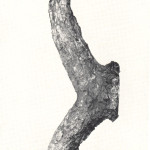 |
M. 14947 |
125 |
17 - PLK |
|
FRLT-f, L/R-HOR-f |
|
106 - Natural History Museum UK (?) |
II |
upper |
|
Leakey LSB. 1965. Olduvai Gorge 1951-1961, Volume 1: Fauna and Background. New York, NY: Cambridge University Press. |
Specimen is pictured in plate 46. According to the author, it is "in bad shape." Gentry and Gentry suggest this specimen probably came from the top of Bed 2 at PLK. |
130 - L.S.B. Leakey |
1936 |
264 - Leakey family expedition |
Yes |
|
Mammalia |
Artiodactyla |
Ruminantia |
|
Bovoidea |
Bovidae |
Bovinae |
Bovini |
Bularchus |
arok |
|
Holotype - Gentry and Gentry (1978) reclassidfied this specimen as Pelorovis oldowayensis. |
No |
|
M. 14948 |
126 |
|
|
CRA-f, L-HOR-f |
|
106 - Natural History Museum UK (?) |
II |
|
|
Leakey LSB. 1965. Olduvai Gorge 1951-1961, Volume 1: Fauna and Background. New York, NY: Cambridge University Press. |
|
130 - L.S.B. Leakey |
|
264 - Leakey family expedition |
Unknown |
|
Mammalia |
Artiodactyla |
Ruminantia |
|
Bovoidea |
Bovidae |
Bovinae |
Bovini |
Bularchus |
arok |
|
Paratype - Gentry and Gentry (1978a) renamed this specimen as P. oldowayensis. |
No |
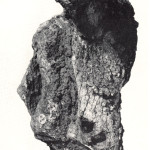 |
M. 21451 |
128 |
18 - VEK |
|
CRA-f, R-HOR-f |
1935 |
106 - Natural History Museum UK (?) |
III, IV |
|
|
Leakey LSB. 1965. Olduvai Gorge 1951-1961, Volume 1: Fauna and Background. New York, NY: Cambridge University Press. |
This holotype was found at the junction of Beds 3 and 4. It is pictured in plates 49 and 50. [This species is documented at SHK II, FLK N I, and BK II (Leakey, 1971).] |
130 - L.S.B. Leakey |
|
264 - Leakey family expedition |
Yes |
|
Mammalia |
Artiodactyla |
Ruminantia |
|
Bovoidea |
Bovidae |
Bovinae |
Bovini |
Gorgon |
olduvaiensis |
|
Holotype - Gentry and Gentry (1978) reclassified this specimen as Connochaetes taurinus olduvaiensis. |
No |
 |
BK II 1955 P.P.F. 1 |
129 |
10 - BK |
|
R-FRO, R-HOR |
1955 |
106 - Natural History Museum UK (?) |
II |
|
|
Leakey LSB. 1965. Olduvai Gorge 1951-1961, Volume 1: Fauna and Background. New York, NY: Cambridge University Press. |
This specimen was incorrectly stated by Leakey (1965) that its museum number is M. 21452 but this was corrected by Gentry and Gentry (1978a). It is pictured in Leakey (1965) plate 52 (lower) and in Gentry and Gentry (1978a) plate 16, figure 3. |
130 - L.S.B. Leakey |
|
264 - Leakey family expedition |
Unknown |
|
Mammalia |
Artiodactyla |
Ruminantia |
|
Bovoidea |
Bovidae |
Bovinae |
Bovini |
Gorgon |
olduvaiensis |
|
This specimen was later reclassified as Connochaetes taurinus olduvaiensis by Gentry and Gentry (1978). |
No |
|
OVPP-Gorgon 1 |
130 |
|
|
L-FRO, L-HOR-f |
|
106 - Natural History Museum UK (?) |
I |
|
|
Leakey LSB. 1965. Olduvai Gorge 1951-1961, Volume 1: Fauna and Background. New York, NY: Cambridge University Press. |
This specimen is in the BMNH collections but a specimen number is not given. |
130 - L.S.B. Leakey |
|
264 - Leakey family expedition |
Unknown |
|
Mammalia |
Artiodactyla |
Ruminantia |
|
Bovoidea |
Bovidae |
Bovinae |
Bovini |
Gorgon |
olduvaiensis |
|
|
No |
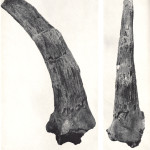 |
M. 14561 |
135 |
20 - JK 1 |
|
HOR |
1936 |
106 - Natural History Museum UK (?) |
III |
|
|
Leakey LSB. 1965. Olduvai Gorge 1951-1961, Volume 1: Fauna and Background. New York, NY: Cambridge University Press. |
|
293 - A.T. Hopwood |
|
264 - Leakey family expedition |
No |
|
Mammalia |
Artiodactyla |
Ruminantia |
|
Bovoidea |
Bovidae |
Alcelaphinae |
Alcelaphini |
Damaliscus |
niro |
|
Holotype - This specimen was reclassified by Gentry and Gentry (1978) as Damaliscus niro. |
No |
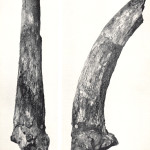 |
M. 21448 |
140 |
|
|
FRO, HOR |
1931 |
106 - Natural History Museum UK (?) |
II |
|
surface |
Leakey LSB. 1965. Olduvai Gorge 1951-1961, Volume 1: Fauna and Background. New York, NY: Cambridge University Press. |
This specimen is pictured in plate 61. |
293 - A.T. Hopwood |
|
264 - Leakey family expedition |
No |
|
Mammalia |
Artiodactyla |
Ruminantia |
|
Bovoidea |
Bovidae |
Hippotraginae |
Hippotragini |
Hippotragus |
gigas |
|
|
No |
|
M. 14564 |
144 |
|
|
HOR-f |
1931 |
106 - Natural History Museum UK (?) |
IV |
|
|
Leakey LSB. 1965. Olduvai Gorge 1951-1961, Volume 1: Fauna and Background. New York, NY: Cambridge University Press. |
This specimen is a fragment of a horn core. It was originally assigned to Hippotragus cf. niger by Leakey and later reassigned to D. niro by Gentry and Gentry (1978a). No locality information is provided. |
130 - L.S.B. Leakey |
|
264 - Leakey family expedition |
Unknown |
|
Mammalia |
Artiodactyla |
Ruminantia |
|
Bovoidea |
Bovidae |
Hippotraginae |
Hippotragini |
Hippotragus |
niger |
|
This specimen was reclassified by Gentry and Gentry (1978) as Damaliscus niro. |
No |
|
M. 21450 |
145 |
10 - BK |
|
L-HOR-f |
|
106 - Natural History Museum UK (?) |
II |
|
|
Leakey LSB. 1965. Olduvai Gorge 1951-1961, Volume 1: Fauna and Background. New York, NY: Cambridge University Press. |
|
130 - L.S.B. Leakey |
|
264 - Leakey family expedition |
No |
|
Mammalia |
Artiodactyla |
Ruminantia |
|
Bovoidea |
Bovidae |
Hippotraginae |
Hippotragini |
Hippotragus |
niger |
|
This specimen was reclassified by Gentry and Gentry (1978) as Damaliscus niro. |
No |
|
M. 14530 |
148 |
|
|
L-HOR-f |
1932 |
106 - Natural History Museum UK (?) |
I |
|
|
Leakey LSB. 1965. Olduvai Gorge 1951-1961, Volume 1: Fauna and Background. New York, NY: Cambridge University Press. |
|
137 - A. Gentry |
|
264 - Leakey family expedition |
No |
Matrix adhering suggests it may have come from Bed 2. |
Mammalia |
Artiodactyla |
Ruminantia |
|
Bovoidea |
Bovidae |
Hippotraginae |
Hippotragini |
Hippotragus |
equinus |
|
This specimen was reclassified by Gentry and Gentry (1978) as Hippotragus gigas. |
No |
|
M. 21449 |
149 |
|
|
R-HOR-f |
1932 |
106 - Natural History Museum UK (?) |
I or II |
|
|
Leakey LSB. 1965. Olduvai Gorge 1951-1961, Volume 1: Fauna and Background. New York, NY: Cambridge University Press. |
The label indicates Bed I but Bed II is written on the specimen and in the register according to the authors. |
130 - L.S.B. Leakey |
|
264 - Leakey family expedition |
No |
|
Mammalia |
Artiodactyla |
Ruminantia |
|
Bovoidea |
Bovidae |
Hippotraginae |
Hippotragini |
Hippotragus |
equinus |
|
This specimen was reclassified by Gentry and Gentry (1978) as Hippotragus gigas. It may be a female H. gigas rather than a male H. equinus. |
No |
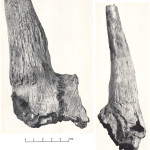 |
M. 14553 |
152 |
|
|
FRO-f, HOR-f |
1931 |
106 - Natural History Museum UK (?) |
II |
|
|
Leakey LSB. 1965. Olduvai Gorge 1951-1961, Volume 1: Fauna and Background. New York, NY: Cambridge University Press. |
This paratype was first described by Schwartz (1937) and is pictured in plate 63. It was excavated by Reck between 1931 and 1935.This specimen is used as the holotype as the original was destroyed in Munich in WWII. |
138 - E. Schwarz |
|
273 - Reck expedition |
No |
|
Mammalia |
Artiodactyla |
Ruminantia |
|
Bovoidea |
Bovidae |
Alcelaphinae |
Alcelaphini |
Damaliscus |
angusticornis |
|
Paratype (Holotype) - This specimen was reclassified by Gentry and Gentry (1978) as Parmularius angusticornis. |
No |
|
OVPP-Damaliscus 1 |
153 |
|
|
CRA, L/R-HOR |
1935 |
106 - Natural History Museum UK (?) |
|
|
|
Leakey LSB. 1965. Olduvai Gorge 1951-1961, Volume 1: Fauna and Background. New York, NY: Cambridge University Press. |
Several other specimens are present in the BMNH. |
138 - E. Schwarz |
|
264 - Leakey family expedition |
Unknown |
|
Mammalia |
Artiodactyla |
Ruminantia |
|
Bovoidea |
Bovidae |
Alcelaphinae |
Alcelaphini |
Damaliscus |
angusticornis |
|
This specimen was reclassified by Gentry and Gentry (1978) as Parmularius angusticornis. |
No |
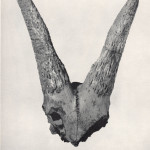 |
M. 21425 |
154 |
19 - SHK |
|
CRA, HOR |
|
106 - Natural History Museum UK (?) |
II |
|
|
Leakey LSB. 1965. Olduvai Gorge 1951-1961, Volume 1: Fauna and Background. New York, NY: Cambridge University Press. |
This specimen is pictured in plates 64 and 65. It was originally listed as Damaliscus angusticornis by Schwartz and Leakey. |
137 - A. Gentry |
|
264 - Leakey family expedition |
Yes |
|
Mammalia |
Artiodactyla |
Ruminantia |
|
Bovoidea |
Bovidae |
Alcelaphinae |
Alcelaphini |
Damaliscus |
angusticornis |
|
This specimen was reclassified by Gentry and Gentry (1978) as Parmularius angusticornis. |
No |
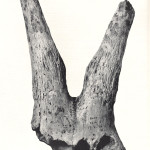 |
M. 21422 |
155 |
18 - VEK |
|
CRA-f, L/R-HOR-f |
1935 |
106 - Natural History Museum UK (?) |
II |
|
|
Leakey LSB. 1965. Olduvai Gorge 1951-1961, Volume 1: Fauna and Background. New York, NY: Cambridge University Press. |
|
138 - E. Schwarz |
|
264 - Leakey family expedition |
No |
Matrix adhering to specimen suggests it came from Bed 2. |
Mammalia |
Artiodactyla |
Ruminantia |
|
Bovoidea |
Bovidae |
Alcelaphinae |
Alcelaphini |
Damaliscus |
angusticornius |
|
This specimen was reclassified by Gentry and Gentry (1978) as Parmularius angusticornis. |
No |
|
M. 21423 |
156 |
19 - SHK |
|
FRLT, L/R-HOR-f |
1935 |
106 - Natural History Museum UK (?) |
II |
|
|
Leakey LSB. 1965. Olduvai Gorge 1951-1961, Volume 1: Fauna and Background. New York, NY: Cambridge University Press. |
|
137 - A. Gentry |
|
264 - Leakey family expedition |
No |
Matrix adhering to the specimen suggests it may come from Bed 4. |
Mammalia |
Artiodactyla |
Ruminantia |
|
Bovoidea |
Bovidae |
Alcelaphinae |
Alcelaphini |
Damaliscus |
angusticornis |
|
This specimen was reclassified by Gentry and Gentry (1978) as Parmularius angusticornis. |
No |
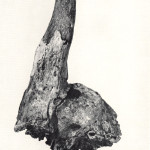 |
M. 21428 |
160 |
18 - VEK |
|
CRA, L/R-HOR-f |
1935 |
106 - Natural History Museum UK (?) |
II |
|
|
Leakey LSB. 1965. Olduvai Gorge 1951-1961, Volume 1: Fauna and Background. New York, NY: Cambridge University Press. |
This specimen is pictured in plates 68 and 69. The specimen has VEK II written on it but it is registered as VEK I. |
138 - E. Schwarz |
|
264 - Leakey family expedition |
Yes |
|
Mammalia |
Artiodactyla |
Ruminantia |
|
Bovoidea |
Bovidae |
Alcelaphinae |
Alcelaphini |
Damaliscus |
angusticornis |
|
Paratype - This specimen was reclassified by Gentry and Gentry (1978) as Parmularius angusticornis. |
No |
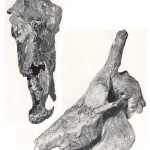 |
M. 14689 |
164 |
11 - HWK |
|
SKULL, MAN |
1931 |
106 - Natural History Museum UK (?) |
I |
upper |
|
Hopwood, A. 1934. New fossil mammals from Olduvai, Tanganyika territory. Annals of the Magazine of Natural History. 10: 546-550. |
This holotype is pictured in plate 70. It was excavated 15 ft. below upper Bed 1 in a "tuffaceous deposit." It was found near the mouth of HWK. |
293 - A.T. Hopwood |
|
|
Yes |
|
Mammalia |
Artiodactyla |
Ruminantia |
|
Bovoidea |
Bovidae |
Alcelaphinae |
Alcelaphini |
Parmularius |
altidens |
|
Holotype |
No |










